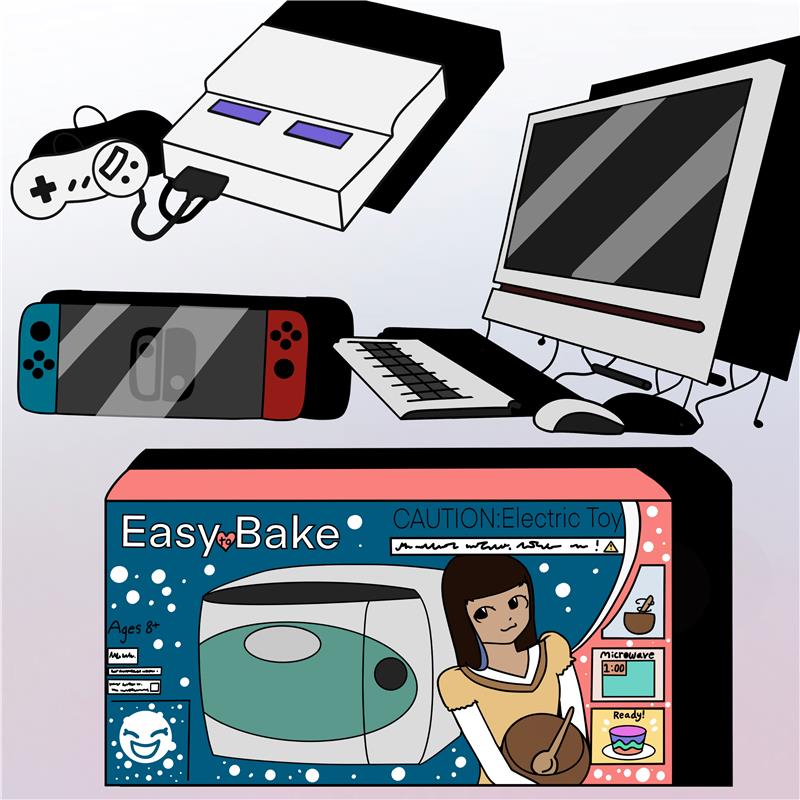Imagine yourself in your room when you were younger. What did you play with? Was it a doll? A toy car? Maybe even a video game console. Whatever it was, there’s no doubt that our childhood toys and technology have changed: the controversy, the nostalgia and the now.
Easy Bake Oven: Hasbro Inc., the creators of the Easy Bake Oven, have gotten in quite a bit of controversy about the safety of the product advertised for children after 278 incidents of children getting their fingers trapped in the toy and even one case where a girl had to have her finger amputated because of the damages caused. In 2007, Hasbro had to recall close to one million Easy Bake Ovens because of the risk they exposed to children, though ovens sold before 2006 were not ordered to be recalled.
After the entire controversy and the 985,000 recalled Easy Bake Ovens, 2006 was the year for improvement. Soon after the controversy, a 13-year-old girl named McKenna Pope started petitioning for gender neutral Easy Bake Ovens as there were only purple and pink, which Hasbro agreed to do with a black and silver Easy Bake Oven in 2013. Even after all the controversy, the Easy Bake Oven is still a very popular toy for children today. The Easy Bake Oven is known as one of the most iconic toys of the 2000s and is said to have helped children learn cooking and baking techniques. In the end, the Easy Bake Oven could not be shaken even after the color of the oven, the injuries, a tragic amputation and the recalls.
Gaming consoles: From the creation of the Atari in the 1970s to the PlayStation 5 (PS5) in 2020, there are so many ways to play video games. In 1976, Atari released a game called “Pong” which was uniquely competitive because of its gameplay. Around the same time that Atari became popular, a new competition rose from the ground. Coleco created Telstar in 1976 with three games: “Tennis”, “Handball” and “Hockey”. They would then release 14 more games until 1978.
Moving on to the 1980s, the decade of excess saw more technical innovations in the market. Games like “Pac-Man”, “Mario Bros.”, and “Final Fantasy” were released. It was in this period that Sega and Nintendo grew in the industry. Sega released the Genesis and Nintendo released the Super Nintendo Entertainment System (SNES). The 1990s saw companies switch to compact discs instead of cartridges, which allowed more 3D games to be created. In 1994 PlayStation would be in the 3D game industry and Nintendo released the Nintendo 64 (N64) soon after.
“It was a big deal for my family when we finally got a Nintendo 64,” Columbia Heights High School (CHHS) math and AVID teacher Mr. Dan Ronchak said. “My brothers and I had saved up some money from our newspaper route to buy the console and four controllers. It was around $200 back then.”
In the present day, video games are something that anyone can play anywhere! A lot of new consoles have come out as well, as so many more video games have been released. Starting off with the Nintendo GameCube, which was the first console with games such as “Super Mario Sunshine”, “Metroid Prime” and “Super Smash Bros. Melee”, there were many games released on this console that would bring games to 3D just as the N64 did. Many PlayStation consoles throughout the years, but most recently the PS5, is said to run faster, have better graphics and more storage capacity than any previous console. No matter which console you pick, they have all come from older versions that have been changed and improved upon many times. However, not all have accepted the change and instead stick to old games! For those people who do not like modern consoles, arcades and vintage stores appeal more to them as they have the video games that they grew up with as kids. People even found ways to emulate classic games on their computer which offers a much easier way for people to play the nostalgic games they prefer.
Computer systems: Computers have been around for about 200 years, going back to when scientists, entrepreneurs or your everyday person needed help with complex math problems! By the middle of the 20th century, however, computers had advanced immensely. Humans have invented machines to do jobs like math or analyze data even better than humans can. People consider the first computer to be the steam-driven calculating machine in 1821, which failed due to the lack of technology in those times. In 1848, Ada Lovelace, an English mathematician, created the first-ever computer program. Her invention translated a piece of paper from French into English. Technology would only continue to improve as the years progressed, and in 1953, we had our first computer language: A-0, or Arithmetic Language version 0. In 1958, the computer chip was invented, for which the inventors Jack Killby and Robert Noyce received a Nobel Prize in Physics.
Computers have grown in popularity ever since their initial invention. From the calculator to modern computers, engineers and inventors have improved a lot in the technology department. With all kinds of apps and the internet itself, computers are now essential to everyday work. From teacher attendance charts to essays, computers have made nearly everything easier. Ask anyone who uses computers every day what life would be like without them. Would they be able to imagine it? Some would be able to, sure, but most wouldn’t. Having to solve complex math problems without a calculator would take too long and fact-checking something for your final draft of an essay would be almost impossible without dozens of textbooks and thousands of pages flipped through. Each country’s safety also relies on computers when it comes to international threats like missiles or threats outside of our planet like asteroids. At the end of the day, we have to remember that computers make the country safer, our lives easier and everyday simple tasks faster. Though some people use technology as a distraction from their work, relationships and responsibilities, computers make life better in so many other ways that this downside is often seen as a necessary cost.
“I’m always excited to see and learn the new tricks that new computers can do,” CHHS art teacher Ms. Sarah Honeywell said. “Of course, there are some drawbacks to each development because sometimes we lose some of the human touches that are present in older technology, such as dark rooms versus digital cameras.”
In the end, the evolution of what we grew up with is unstoppable. Some might’ve grown up with a computer, others with a SNES and others might not have grown up with anything technological, but they are all changing and we are finding new ways to implement them in our lives every day. From the PS5 to new, better computers, people rely on them all. Even the Easy Bake Oven was an early introduction to using mechanical and electrical technology given to children. One thing is certain—no matter the controversy, the competition or the original invention’s use, we can all agree that these nostalgic products have shaped our society in more ways than one!









